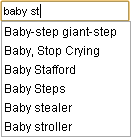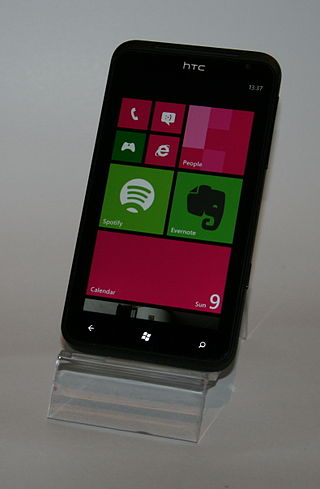
Microsoft Word is a word processor developed by Microsoft. It was first released on October 25, 1983, under the name Multi-Tool Word for Xenix systems. Subsequent versions were later written for several other platforms including: IBM PCs running DOS (1983), Apple Macintosh running the Classic Mac OS (1985), AT&T UNIX PC (1985), Atari ST (1988), OS/2 (1989), Microsoft Windows (1989), SCO Unix (1990), macOS (2001), Web browsers (2010), iOS (2014) and Android (2015). Using Wine, versions of Microsoft Word before 2013 can be run on Linux.

Windows Notepad is a simple text editor for Windows; it creates and edits plain text documents. First released in 1983 to commercialize the computer mouse in MS-DOS, Notepad has been part of every version of Windows ever since.

A smartphone is a mobile device that combines the functionality of a traditional mobile phone with advanced computing capabilities. It typically has a touchscreen interface, allowing users to access a wide range of applications and services, such as web browsing, email, and social media, as well as multimedia playback and streaming. Smartphones have built-in cameras, GPS navigation, and support for various communication methods, including voice calls, text messaging, and internet-based messaging apps.

Autocomplete, or word completion, is a feature in which an application predicts the rest of a word a user is typing. In Android and iOS smartphones, this is called predictive text. In graphical user interfaces, users can typically press the tab key to accept a suggestion or the down arrow key to accept one of several.

WordPad is a word processor included with Windows 95 and later. Similarly to its predecessor Microsoft Write, it is a basic word processor, positioned as more advanced than the Notepad text editor by supporting rich text editing, but with a subset of the functionality of Microsoft Word.
Push email is an email system that provides an always-on capability, in which when new email arrives at the mail delivery agent (MDA), it is immediately, actively transferred (pushed) by the MDA to the mail user agent (MUA), also called the email client, so that the end-user can see incoming email immediately. This is in contrast with systems that check for new incoming mail every so often, on a schedule. Email clients include smartphones and, less strictly, IMAP personal computer mail applications.

A virtual keyboard is a software component that allows the input of characters without the need for physical keys. Interaction with a virtual keyboard happens mostly via a touchscreen interface, but can also take place in a different form when in virtual or augmented reality.
The Motorola Q is a Windows Mobile smartphone first announced in the Summer of 2005 as a thin device with similar styling to Motorola's immensely popular RAZR. Motorola in a partnership with Verizon Wireless released the Q on May 31, 2006. A version for Sprint was released early in January 2007 and one for Amp'd Mobile in April 2007.
A text entry interface or text entry device is an interface that is used to enter text information in an electronic device. A commonly used device is a mechanical computer keyboard. Most laptop computers have an integrated mechanical keyboard, and desktop computers are usually operated primarily using a keyboard and mouse. Devices such as smartphones and tablets mean that interfaces such as virtual keyboards and voice recognition are becoming more popular as text entry systems.
Smart tags are an early selection-based search feature, found in later versions of Microsoft Word and beta versions of the Internet Explorer 6 web browser, by which the application recognizes certain words or types of data and converts it to a hyperlink. It is also included in other Microsoft Office programs as well as Visual Web Developer. Selection-based search allows a user to invoke an online service from any other page using only the mouse. Microsoft had initially intended the technology to be built into its Windows XP operating system but changed its plans due to public criticism.
The Cupertino effect occurs when a spell checker erroneously replaces or flags correctly spelled words that are not in its dictionary, including words that may be recognized as standard or permissible by other dictionaries.

Windows Phone (WP) is a discontinued mobile operating system developed by Microsoft for smartphones as the replacement successor to Windows Mobile and Zune. Windows Phone featured a new user interface derived from the Metro design language. Unlike Windows Mobile, it was primarily aimed at the consumer market rather than the enterprise market.

Capsule is an event planning and private group based multi-media and photo sharing social platform. Founded in 2011, it provides members with a way to share event information among group members through its website or mobile app. It has been featured in The Huffington Post and New York Mag as a top app for weddings.

In a speed typing contest contestants compete to attain the highest accurate typing speeds. These contests have been common in North America since the 1930s and were used to test the relative efficiency of typing with the Dvorak and QWERTY keyboard layouts.

Microsoft SwiftKey is a virtual keyboard app originally developed by TouchType for Android and iOS devices. It was first released for Android in July 2010, followed by an iOS release in September 2014 following Apple's implementation of third-party keyboard support.

Windows Phone 7 is the first release of the Windows Phone mobile client operating system, released worldwide on October 21, 2010, and in the United States on November 8, 2010. It runs on the Windows CE 6.0 kernel.

Fleksy is a third-party, proprietary virtual keyboard app for Android and iOS devices. It attempts to improve traditional typing speed and accuracy through enhanced auto-correction and gesture controls. Fleksy uses error-correcting algorithms that analyze the region where the user touches the keyboard and feeds this through a language model, which calculates and identifies the intended word. Swiping gestures are used to control common functions, such as space, delete, and word correction.

Microsoft Band 2 was the second-generation smart band with smartwatch features developed by Microsoft. Announced on October 6, 2015, it succeeded the original Microsoft Band and was initially available in the United States, United Kingdom and Canada. It was later also available in Australia through the Sydney flagship store, Microsoft online store, and selected retailers such as JB Hi-Fi and Harvey Norman. Like its predecessor, it incorporates fitness tracking and is compatible with Windows, iOS and Android smartphones via a Bluetooth connection. On October 3, 2016, it was discontinued. On May 31, 2019, the Band's companion app stopped working and Microsoft offered refunds for customers who were still active platform users.

Phone Link, previously Your Phone, is a syncing software developed by Microsoft to connect Windows PCs to Android and iOS mobile devices to view notifications, make phone calls, use mobile apps amongst others, via the PC. It is a native component of Windows 10 and Windows 11, where it is a UWP app and consists of a driver that communicates with the mobile device, where it is named the Link to Windows app. Phone Link makes use of Wi-Fi, Bluetooth for voice calls, or mobile data; it syncs via Microsoft servers, meaning that an internet connection is required.

Google Messages is a text messaging software application developed by Google for its Android and Wear OS mobile operating systems, while it's also available via the Web.















